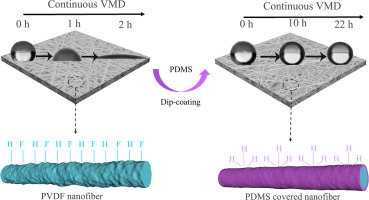当前位置:
X-MOL 学术
›
Desalination
›
论文详情
Our official English website, www.x-mol.net, welcomes your
feedback! (Note: you will need to create a separate account there.)
Low surface energy nanofibrous membrane for enhanced wetting resistance in membrane distillation process
Desalination ( IF 8.3 ) Pub Date : 2020-02-01 , DOI: 10.1016/j.desal.2019.114210 Lei Jiao , Kangkang Yan , Jing Wang , Saisai Lin , Ge Li , Fei Bi , Lin Zhang
Desalination ( IF 8.3 ) Pub Date : 2020-02-01 , DOI: 10.1016/j.desal.2019.114210 Lei Jiao , Kangkang Yan , Jing Wang , Saisai Lin , Ge Li , Fei Bi , Lin Zhang

|
Abstract Membranes with hierarchical structure have higher water contact angle due to affording more air pockets in its nano-micro regions, and then have been known as more hydrophobic. However, the hydrophobicity could be vanished after air in pockets has been exhausted such as in the vacuum membrane distillation (VMD) process. Here, an intrinsically hydrophobic electrospun nanofiber membrane (ENM), whose hydrophobicity is entirely depended on these materials surface energy, was proposed to promote the wetting resistance without the aid of any hierarchical structure. The novel composite ENMs were fabricated using polyvinylidene fluoride (PVDF) as matrix material, and then covered it with polydimethylsiloxane (PDMS) of much lower surface energy via a facile dip-coating. Scanning electron microscope (SEM) images of nanofibers in composite ENMs showed almost no hierarchical structure was existed, while the hierarchical structure was supposed to lower water contact angle in theory. However, the composite ENMs exhibited a higher water-repellency as the surface energy of nanofibers became lower. Therefore, the composite ENMs cannot be wetted by condensed vapor throughout the MD process, and a thinner membrane exhibited an excellent durability in the continuous vacuum MD tests. The result indicated that for the ENMs material of intrinsic hydrophobicity, the low surface energy is the essential quality to exhibit the strong and durable wetting resistance in VMD process, what is difficult to achieve by conventionally hierarchical architecture constructing on membrane surface.
中文翻译:

用于增强膜蒸馏过程中的抗润湿性的低表面能纳米纤维膜
摘要 具有层次结构的膜由于在其纳米微区提供更多的气穴而具有更高的水接触角,因此被称为更疏水。然而,在袋中的空气被耗尽后,疏水性可能会消失,例如在真空膜蒸馏 (VMD) 过程中。在这里,提出了一种固有疏水性电纺纳米纤维膜(ENM),其疏水性完全取决于这些材料的表面能,被提议在没有任何分级结构的帮助下提高抗润湿性。新型复合 ENM 使用聚偏二氟乙烯 (PVDF) 作为基质材料制造,然后通过简单的浸涂用表面能低得多的聚二甲基硅氧烷 (PDMS) 覆盖。复合 ENM 中纳米纤维的扫描电子显微镜 (SEM) 图像显示几乎不存在分层结构,而分层结构理论上应该降低水接触角。然而,随着纳米纤维的表面能变低,复合 ENMs 表现出更高的疏水性。因此,复合 ENMs 不能在整个 MD 过程中被冷凝蒸汽润湿,并且更薄的膜在连续真空 MD 测试中表现出优异的耐久性。结果表明,对于具有内在疏水性的 ENMs 材料,低表面能是在 VMD 过程中表现出强大而持久的耐湿性的必要品质,这是传统的膜表面分层结构构建难以实现的。而分层结构理论上应该降低水接触角。然而,随着纳米纤维的表面能变低,复合 ENMs 表现出更高的疏水性。因此,复合 ENMs 不能在整个 MD 过程中被冷凝蒸汽润湿,并且更薄的膜在连续真空 MD 测试中表现出优异的耐久性。结果表明,对于具有内在疏水性的 ENMs 材料,低表面能是在 VMD 过程中表现出强大而持久的耐湿性的必要品质,这是传统的膜表面分层结构构建难以实现的。而分层结构理论上应该降低水接触角。然而,随着纳米纤维的表面能变低,复合 ENMs 表现出更高的疏水性。因此,复合 ENMs 不能在整个 MD 过程中被冷凝蒸汽润湿,并且更薄的膜在连续真空 MD 测试中表现出优异的耐久性。结果表明,对于具有内在疏水性的 ENMs 材料,低表面能是在 VMD 过程中表现出强大而持久的耐湿性的必要品质,这是传统的膜表面分层结构构建难以实现的。随着纳米纤维的表面能变低,复合 ENM 表现出更高的疏水性。因此,复合 ENMs 不能在整个 MD 过程中被冷凝蒸汽润湿,并且更薄的膜在连续真空 MD 测试中表现出优异的耐久性。结果表明,对于具有内在疏水性的 ENMs 材料,低表面能是在 VMD 过程中表现出强大而持久的耐湿性的必要品质,这是传统的膜表面分层结构构建难以实现的。随着纳米纤维的表面能变低,复合 ENM 表现出更高的防水性。因此,复合 ENMs 不能在整个 MD 过程中被冷凝蒸汽润湿,并且更薄的膜在连续真空 MD 测试中表现出优异的耐久性。结果表明,对于具有内在疏水性的 ENMs 材料,低表面能是在 VMD 过程中表现出强大而持久的耐湿性的必要品质,这是传统的膜表面分层结构构建难以实现的。
更新日期:2020-02-01
中文翻译:

用于增强膜蒸馏过程中的抗润湿性的低表面能纳米纤维膜
摘要 具有层次结构的膜由于在其纳米微区提供更多的气穴而具有更高的水接触角,因此被称为更疏水。然而,在袋中的空气被耗尽后,疏水性可能会消失,例如在真空膜蒸馏 (VMD) 过程中。在这里,提出了一种固有疏水性电纺纳米纤维膜(ENM),其疏水性完全取决于这些材料的表面能,被提议在没有任何分级结构的帮助下提高抗润湿性。新型复合 ENM 使用聚偏二氟乙烯 (PVDF) 作为基质材料制造,然后通过简单的浸涂用表面能低得多的聚二甲基硅氧烷 (PDMS) 覆盖。复合 ENM 中纳米纤维的扫描电子显微镜 (SEM) 图像显示几乎不存在分层结构,而分层结构理论上应该降低水接触角。然而,随着纳米纤维的表面能变低,复合 ENMs 表现出更高的疏水性。因此,复合 ENMs 不能在整个 MD 过程中被冷凝蒸汽润湿,并且更薄的膜在连续真空 MD 测试中表现出优异的耐久性。结果表明,对于具有内在疏水性的 ENMs 材料,低表面能是在 VMD 过程中表现出强大而持久的耐湿性的必要品质,这是传统的膜表面分层结构构建难以实现的。而分层结构理论上应该降低水接触角。然而,随着纳米纤维的表面能变低,复合 ENMs 表现出更高的疏水性。因此,复合 ENMs 不能在整个 MD 过程中被冷凝蒸汽润湿,并且更薄的膜在连续真空 MD 测试中表现出优异的耐久性。结果表明,对于具有内在疏水性的 ENMs 材料,低表面能是在 VMD 过程中表现出强大而持久的耐湿性的必要品质,这是传统的膜表面分层结构构建难以实现的。而分层结构理论上应该降低水接触角。然而,随着纳米纤维的表面能变低,复合 ENMs 表现出更高的疏水性。因此,复合 ENMs 不能在整个 MD 过程中被冷凝蒸汽润湿,并且更薄的膜在连续真空 MD 测试中表现出优异的耐久性。结果表明,对于具有内在疏水性的 ENMs 材料,低表面能是在 VMD 过程中表现出强大而持久的耐湿性的必要品质,这是传统的膜表面分层结构构建难以实现的。随着纳米纤维的表面能变低,复合 ENM 表现出更高的疏水性。因此,复合 ENMs 不能在整个 MD 过程中被冷凝蒸汽润湿,并且更薄的膜在连续真空 MD 测试中表现出优异的耐久性。结果表明,对于具有内在疏水性的 ENMs 材料,低表面能是在 VMD 过程中表现出强大而持久的耐湿性的必要品质,这是传统的膜表面分层结构构建难以实现的。随着纳米纤维的表面能变低,复合 ENM 表现出更高的防水性。因此,复合 ENMs 不能在整个 MD 过程中被冷凝蒸汽润湿,并且更薄的膜在连续真空 MD 测试中表现出优异的耐久性。结果表明,对于具有内在疏水性的 ENMs 材料,低表面能是在 VMD 过程中表现出强大而持久的耐湿性的必要品质,这是传统的膜表面分层结构构建难以实现的。











































 京公网安备 11010802027423号
京公网安备 11010802027423号